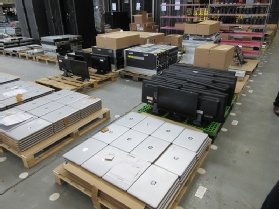
HPE refurbishes legacy IT assets to make money for users
HPE Financial Services is giving old IT assets a new lease of life at its tech renewal site in Erskine, near Glasgow, as part of a promotion of the circular economy
HPE Financial Services is giving old kit a new lease of life at its technology renewal site in Erskine, near Glasgow.
Jackie Rafferty, the operations manager at the supplier’s Technology Renewal Centre – which has a twin facility in Andover, Massachusetts, US – was in charge of PC production for Compaq at the same site in the 1990s. HP acquired Compaq in 2002.
Computer Weekly was recently represented on a tour of the Erskine facility that Rafferty led. He recounted how, in the 1990s, the workforce was producing 8,000 to 10,000 computers every 12 hours. “We were the most efficient [factory] per square foot in the world at that time,” said Rafferty.
After HP merged with Compaq in May 2002, it began a process of relocating manufacturing and moved part of its financial services division to Erskine. Part of the division’s remit has become to refurbish used computers – and not just HP’s, which are now manufactured and sold by HP Inc.
HPE was set up in 2014, when Hewlett Packard (HP) split its traditional PC and printers business from its enterprise products and services, to become HP Inc and Hewlett Packard Enterprise, respectively. HPE Financial Services is one of five business divisions at HPE. It provides investment services and financial architectures for the supplier’s customers and employs 1,500 people across 52 countries.
The Erskine renewal centre opened in 2011 and is today over 13,000m2 in extent.

Rafferty said that thanks to their heritage in manufacturing, the Erskine staff made short work of making a success of the venture.
All 205 workers on the line at the facility have been security cleared by the police and the Ministry of Defence. His son is one of the employees of what is a steady local employer, with a long-standing presence in the area.
As for the laptops, servers and other equipment that comes into the facility, each item is given an asset tracking number, and is then sanitised and tested. The data is wiped from each machine using Blancco software, confirmed David Connell, engineering manager at the Technology Renewal Centre. Connell is, like his colleague, a 32-year veteran at the site. He told the tour group that the entire process is managed using a new Microsoft Dynamics enterprise resource planning (ERP) system.
A minority of the machines are recycled, but most – nearly 90% – get refurbished, boxed up and sold as pre-owned, mostly to wholesalers, in a bid round process. That revenue is then partly shared with those HPE customers who have returned the technology.
HPE started its refurbishing business more than 20 years ago, in the late 1990s. It now manages, according to a spokesperson, the largest IT manufacturer refurbishing facility in world, with 37,000m2 in Andover.
In 2018, the supplier processed four million units of technology – 1.7 million datacentre and 2.3 million workspace units. Some 89% of this equipment was remarketed and returned to active use, while 11% was recycled.
Monetising retired IT
But there is also an economic aspect to the site’s activity of interest to CIOs. HPE says that in 2018, it returned $330m to customers by way of the “HPE Asset Upcycling and HPE Accelerated Migrations” programme. This should, at least in theory, enable IT organisations to shift financial resources to innovation, capitalising on the retired IT assets.
And so the Erskine site’s activity chimes in with an overarching HPE business theme – how it promotes the “circular economy”, more broadly.
In a presentation coinciding with the tour, Gerri Gold, chief operating officer for HPE Financial Services, presented US Chamber of Commerce statistics, from 2017, showing that physical IT equipment accounts for 72.9% of initial capital expenditure for a typical large datacentre, amounting to $157m, and that the under-utilisation of IT assets is a major cost for corporate organisations, with 56% average storage utilisation and 30% of datacentre servers lying idle in the US. A similar picture can be expected for the UK.
“You can have the best technologies, the best solutions, the best processes, but if you can’t afford it, you are not going anywhere,” said Gold.
“For us, economics is all about how we help our customers optimise their IT investment. It’s not just about leasing [equipment], it has to be multi-vendor, it has to be global, and it has to be about customers’ existing IT – what’s already in their base.
“The role of the CIO is changing, and one of the elements of that is the increased complexity in their IT financial management. Monetising what they have in their existing IT is part of that picture,” she said.
Read more about sustainability and the circular economy
- What is the Circular Economy?
- How IoT could be sustainability's secret ingredient
- Find out what happens to your smartphone after you’re finished with it and why you should commit to the circular economy.








